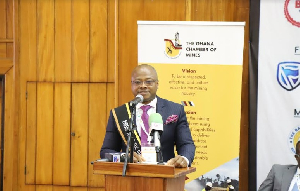 Michael Akafia, President of the Ghana Chamber of Mines
Michael Akafia, President of the Ghana Chamber of Mines
The Ghana Chamber of Mines has reported a 4.3 percent growth in mineral revenue from its producing member companies, rising from US$5.6 billion in 2022 to US$5.8 billion in 2023.
According to the President of the Chamber, Michael Akafia, the growth was primarily driven by an expansion in gold export receipts, which offset a downturn in manganese export proceeds.
“Gold production revenue rose from US$5.4 billion in 2022 to US$5.7 billion in 2023, marking a growth of 4.8 percent. In contrast, manganese revenue declined from US$201.4 million to US$183.2 million, equivalent to a downturn of 9 percent,” he stated.
The rise in gold revenue was primarily due to an increase in the price of the yellow metal, which compensated for a contraction in output from 3 million ounces in 2022 to 2.9 million ounces in 2023.
Mr. Akafia was speaking at the Chamber’s 95th Annual General Meeting in Accra, and said this 6.1 percent reduction in production was attributed to steep declines in the output of several member companies. These include Adamus Resources, AngloGold Ashanti Obuasi Mine, Asanko Gold Mines Ltd., FGR Bogoso Prestea Ltd., Golden Star Wassa Ltd., Newmont Golden Ridge Ltd., and Abosso Goldfields Ltd.
However, Newmont’s Ahafo Mine saw its share in the total gold output of the Chamber’s producing members improve from 18.9 percent in 2022 to 20.3 percent in 2023.
Conversely, Newmont’s Akyem Mine saw a fall in its contribution from 13.8 percent in 2022 to 10.3 percent in 2023 due to a reduction in output.
“The production performance of Gold Fields’ mines in Ghana was mixed. The Tarkwa Mine reported an increase in production, leading to an improvement in the mine’s share of the Chamber’s gold output from 17.5 percent in 2022 to 19.3 percent in 2023.”
However, the Damang Mine saw a decline in output, resulting in a decrease in its contribution to the total gold output of the Chamber’s producing member companies from 7.6 percent in 2022 to 5.3 percent in 2023.
On the back of these developments, the Chamber’s President said: “The average cost of producing an ounce of gold, as measured by the World Gold Council’s proprietary parameter All-In Sustaining Cost (AISC), rose by 7.4 percent to US$1,542 per ounce in 2023 – higher than the global average increase of 5.3 percent.”
This cost escalation, he stated, was driven by reduced production volumes, inflation of mining consumables, and increased government levies.
For instance, Newmont’s Ahafo Mine saw its AISC rise by 3.7 percent to US$1,222 per ounce, while the Akyem Mine’s AISC surged by 24.5 percent to US$1,210 per ounce, reflecting the reduced production and higher costs.
Additionally, he indicated that Gold Fields’ Tarkwa Mine reported a 3.6 percent increase in AISC to US$1,293 per ounce, and the Damang Mine experienced a significant rise of 55 percent to US$1,679 per ounce due to lower gold sales and higher costs.
Despite these challenges, he maintained that the Chamber of Mines remains optimistic about the sector’s future, emphasizing the need for operational efficiencies and cost management.
Among other things, the Chamber also reiterated the importance of addressing regulatory and infrastructural issues to enhance the competitiveness of the country’s mining industry.
Furthermore, Mr. Akafia enumerated a number of challenges confronting the industry, including the imposition of the Growth and Sustainability Levy, the price build-up of petroleum products, and issues with the Income Tax Act, 2015 (Act 896).
Other challenges include the Value Added Tax (VAT) Flat Rate Scheme, delays in the approval of permits for exploration, and the exclusion of consumables from the mining list.